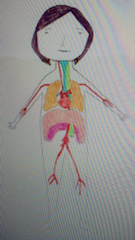Biology of breathing - experiential
- I invite you to bring your attention - your sensory awareness - to the areas in our body where it's easy to breathe, (pause)
- then to areas where it's more difficult to breathe (pause)
- now, place your hand on your middle
- notice how it alternately rises and settles
Please look at our lovely model

Notice the pink hump in her middle - that’s her diaphragm.
When your hand was on your middle, you felt your diaphragm alternately rise and settle
This movement alternately creates and releases a vacuum that pulls air into your lungs, and releases it.
- Notice that the girl's heart and lungs rest on her diaphragm.
- Her stomach and other internal organs (not depicted) nestle under it.
- When her diaphragm is relaxed, her breathing will be full and even, and her breathing will give those organs a soothing massage that supports their digestive functions.
Please bring your attention to your next 12 breaths - without forcing air in or out.
- Notice where your breath flows easily and where it does not.
- Then scan you body
- Notice what changes you experience.
On our model, notice what penetrates the diaphragm:
- a major blood vessel (aorta)
- her esophagus connecting her mouth to her stomach
- her vagus nerve that regulates vital bodily functions (v. nerve not depicted, so please take my word for it.)
Can you see how relaxing your diaphragm (reducing constriction) supports
- Circulation throughout your body
- Digestion (Got reflux; heartburn? See how relaxing diaphragm tension could ease that?
- Spine - Your diaphragm is a disc-shaped muscle that also attaches to your spine. (When clients complain of back pain, they often feel relief when I help them relax their diaphragm.)
- Lungs - getting enough air depends on a supple diaphragm.
- Taking in oxygen relies on the diaphragm creating a vacuum that pulls in air. If your diaphragm is tense it doesn’t move much.
- Your body depends on your Lungs’ capacity to oxygenate 5 quarts of blood/min. Shallow breathing may only oxygenate 1 quart/min.
- Breathing is usually an automatic activity. If you have panic attacks or your body needs some remedial help with any of the above, the practice of conscious breathing may help.*
Suggested activity: Bring your awareness to your breathing when you're walking, driving, cooking, cleaning - and especially when you're using a computer or other digital device. What do you notice?
* I invite you to check out Breathing Patterns on my blog

